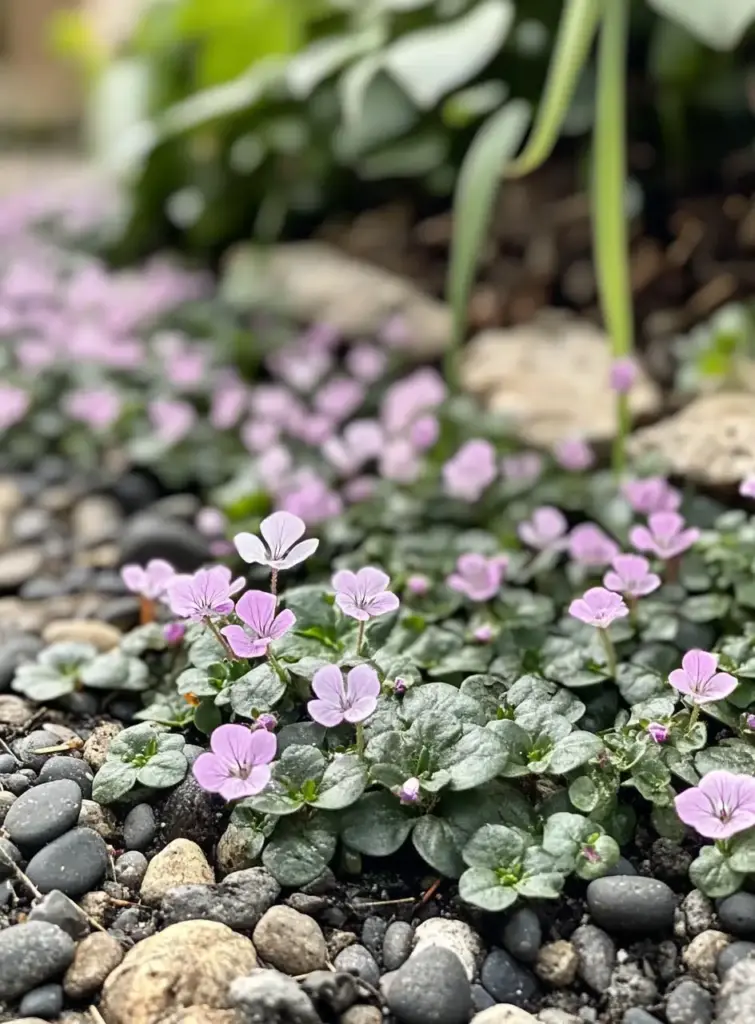If you’re looking to enhance your garden’s charm while keeping it practical, walkable ground cover plants offer an ideal solution. These low-growing, resilient plants can turn dull, lifeless pathways or gaps between stepping stones into vibrant, living carpets that tolerate light foot traffic with ease. In addition to their functionality, many walkable ground cover varieties offer seasonal color, delightful fragrance, and weed-suppressing qualities that elevate the look and feel of your outdoor space.
Whether you’re crafting a new garden path or looking to replace your traditional lawn with something more eco-conscious, adding walkable ground cover is a smart move. These plants bring softness and texture to your design, and many are both drought-tolerant and low-maintenance, making them perfect for sustainable landscaping. From sun-loving perennials to shade-tolerant ground cover options, there’s a walkable ground cover plant to match every growing condition and garden aesthetic.
Table of Contents
1. Thyme (Thymus spp.)
Thyme is one of the most beloved walkable ground cover plants for sunny gardens, offering fragrant foliage and exceptional durability. Nonculinary varieties like red creeping thyme, ‘Elfin’ mother-of-thyme, and woolly thyme form dense, mat-like clusters that tolerate occasional foot traffic. When brushed against, they release a delightful herbal aroma that enhances the garden experience.
- Light: Full sun
- Height: Up to 5 inches
- USDA Zones: 4–9
- Best Uses: Between stepping stones, borders, or rock gardens
- Bonus: Deer- and rabbit-resistant
Pro Tip: Plant thyme along paths where you’ll frequently walk to enjoy its scent and soft texture.
2. Blue Star Creeper (Isotoma fluviatilis)
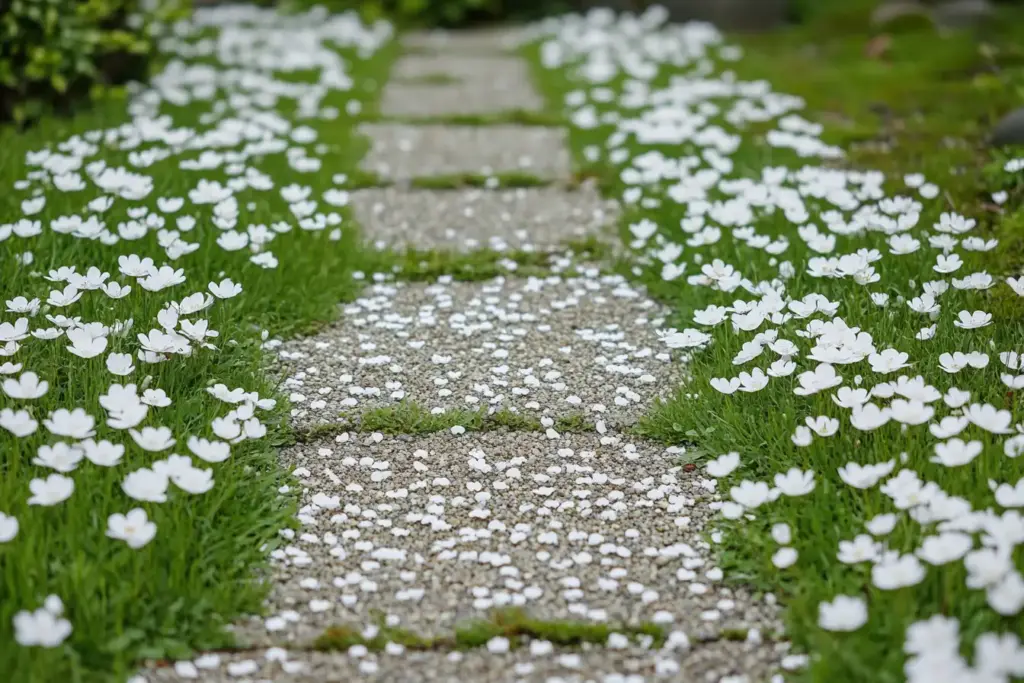
For shady or partially shaded paths, blue star creeper is a charming solution. This low-spreading plant produces masses of tiny, star-shaped, pale blue flowers in spring and early summer. Its fine texture creates a soft, green carpet that handles moderate foot traffic when well-watered.
- Light: Full sun to part shade
- Height: Up to 4 inches
- USDA Zones: 5–9
- Best Uses: Lawn alternative in shaded areas, between pavers
- Bonus: Fast-spreading via underground runners
Note: In cooler, moist climates, this plant can spread aggressively—keep an eye on its boundaries.
3. Sedum (Sedum spp.)
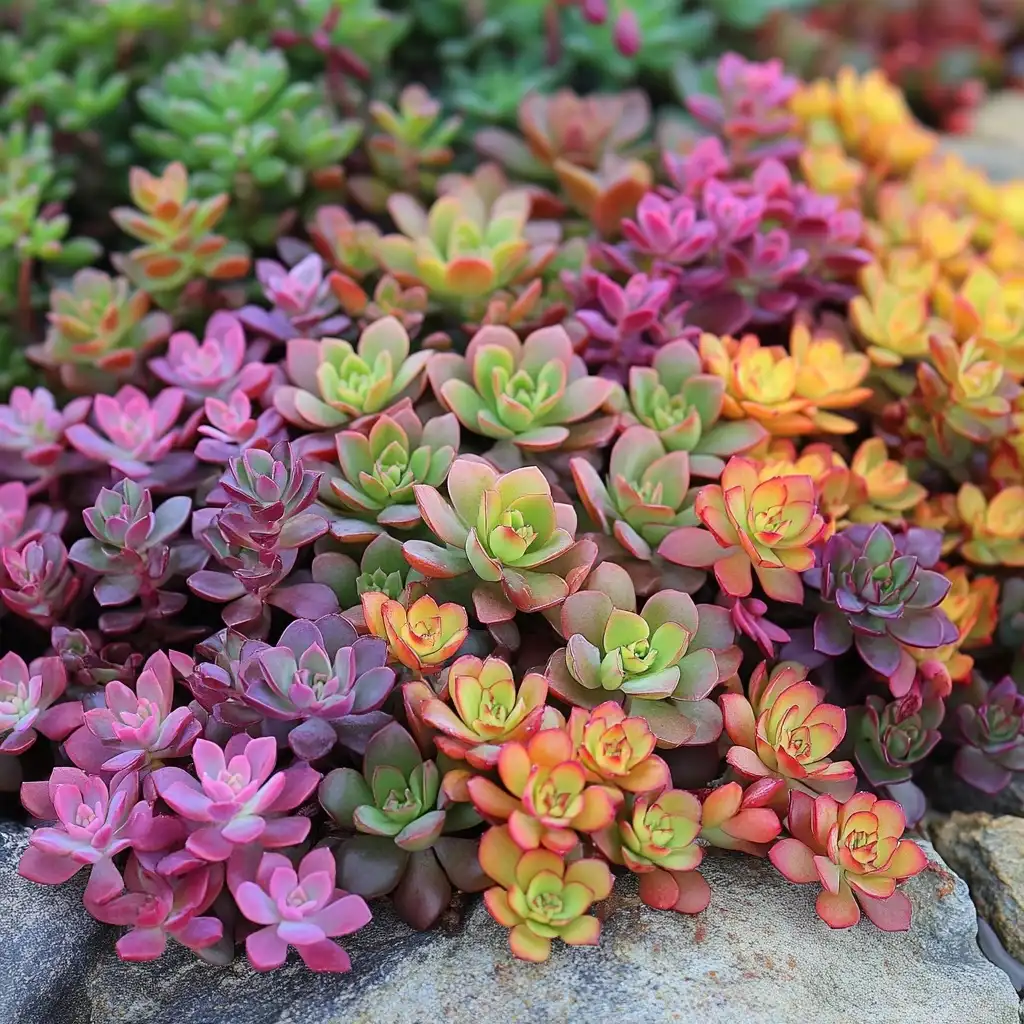
Sedum, also known as stonecrop, is a heat- and drought-tolerant succulent that thrives in sun-soaked spots. Ideal for low-maintenance pathways, sedum’s diverse colors and forms—from ‘Dragon’s Blood’ to ‘Blue Spruce’—add visual interest while standing up to light foot traffic.
- Light: Full sun to part shade
- Height: Up to 6 inches
- USDA Zones: 3–10
- Best Uses: Between stepping stones, sunny borders, or erosion control
- Bonus: Attracts pollinators with its late-summer blooms
Installation Tip: Use sedum “tiles” or plugs for quick coverage along paths.
4. Ajuga (Bugleweed) (Ajuga reptans)
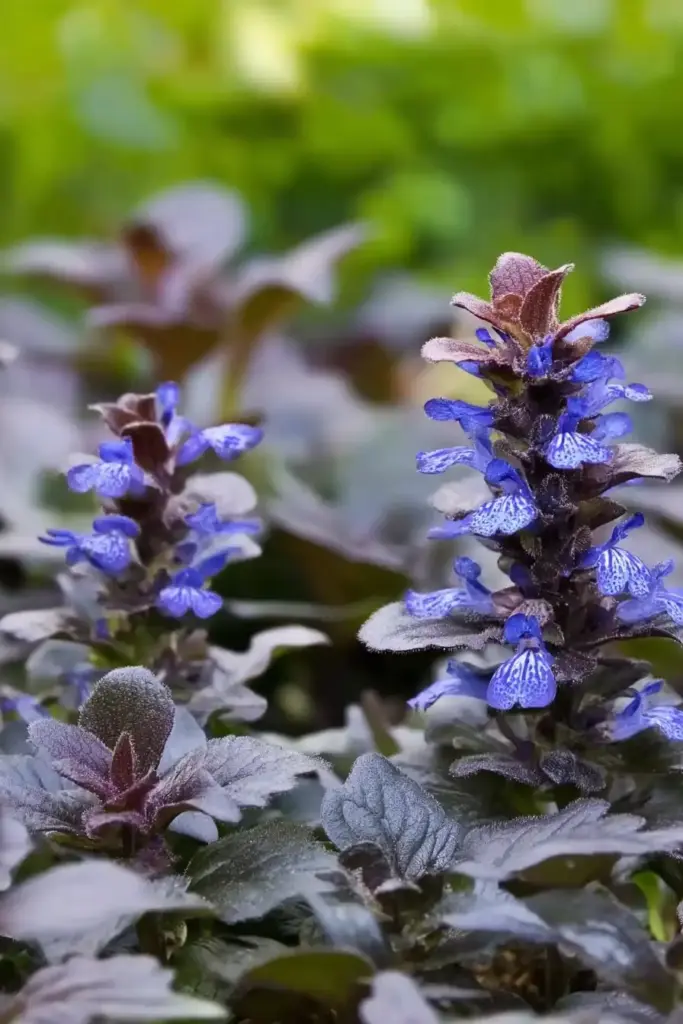
Ajuga is a hardy, shade-tolerant ground cover known for its dense, colorful foliage and springtime flower spikes. This walkable ground cover works well in woodland gardens or under trees, where other plants might struggle. It adds a pop of purple, bronze, or green depending on the variety.
- Light: Full to part shade
- Height: Up to 9 inches
- USDA Zones: 4–10
- Best Uses: Shaded paths, underplanting, or as a lawn substitute
- Bonus: Spreads steadily but remains relatively easy to manage
Gardening Tip: Space plants 6–9 inches apart to create a quick, weed-smothering carpet.
5. Creeping Jenny (Moneywort) (Lysimachia nummularia)
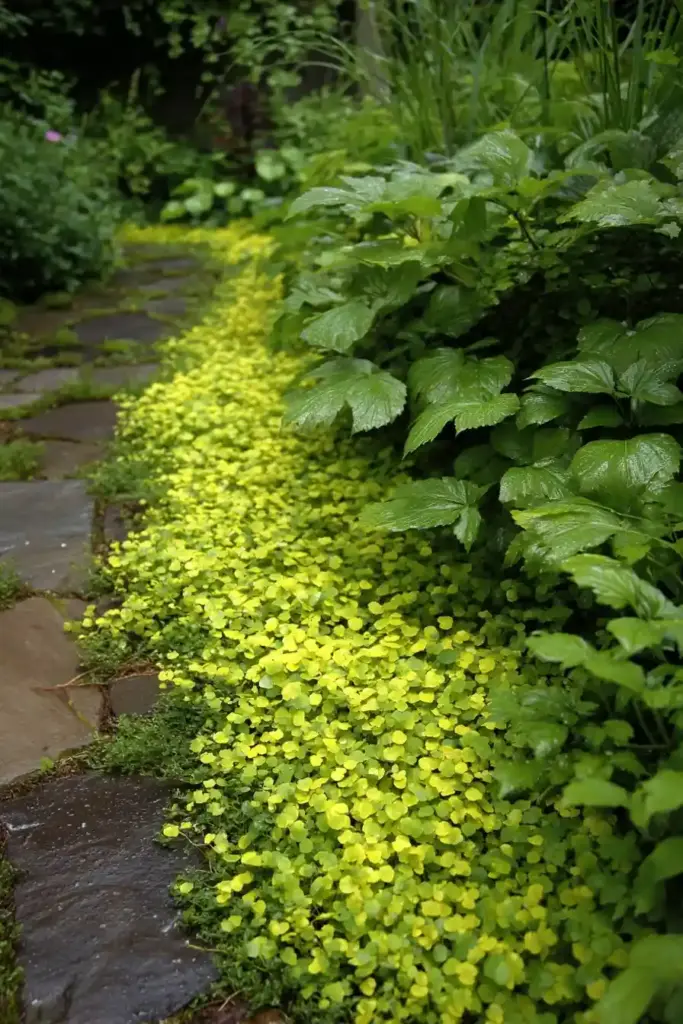
Creeping Jenny is a fast-growing, low-profile ground cover with trailing stems and bright chartreuse foliage. Its round, coin-like leaves add texture and color to garden paths, especially in contrast with stone or wood.
- Light: Full sun to part shade
- Height: Up to 6 inches
- USDA Zones: 3–9
- Best Uses: Around stepping stones, container edges, or small slopes
- Bonus: Produces small yellow flowers in late spring
Control Tip: Though vigorous, it’s easily contained with edging or by growing in planters.
6. Portulaca (Moss Rose) (Portulaca grandiflora)
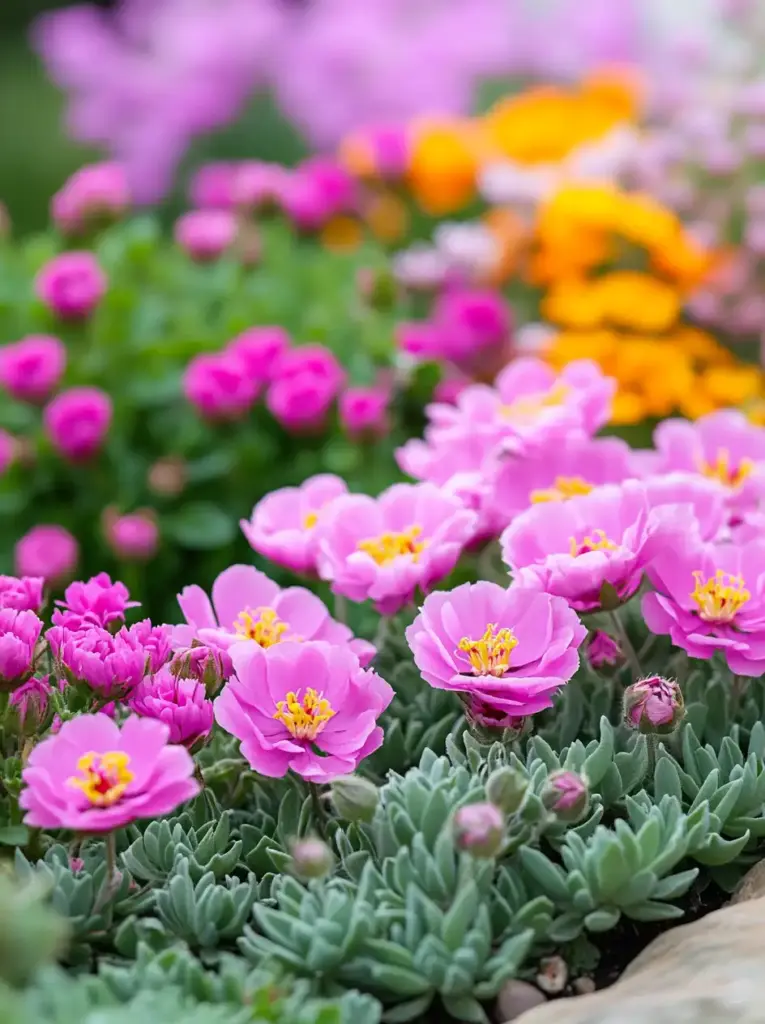
Portulaca, or moss rose, is a sun-worshipping annual in most regions, known for its vibrant, paper-like flowers and succulent, needle-shaped leaves. It thrives in hot, dry areas and is remarkably resilient when stepped on lightly. Though it’s not a perennial in cooler climates, it often self-seeds and returns year after year.
- Light: Full sun
- Height: Up to 9 inches
- USDA Zones: 10–11 (annual elsewhere)
- Best Uses: Between pathway stones, sunny slopes, containers
- Bonus: Drought-tolerant and blooms in a variety of vivid colors
Maintenance Tip: Give it well-drained soil and avoid overwatering—it thrives on neglect.
7. Scotch Moss (Sagina subulata ‘Aurea’)
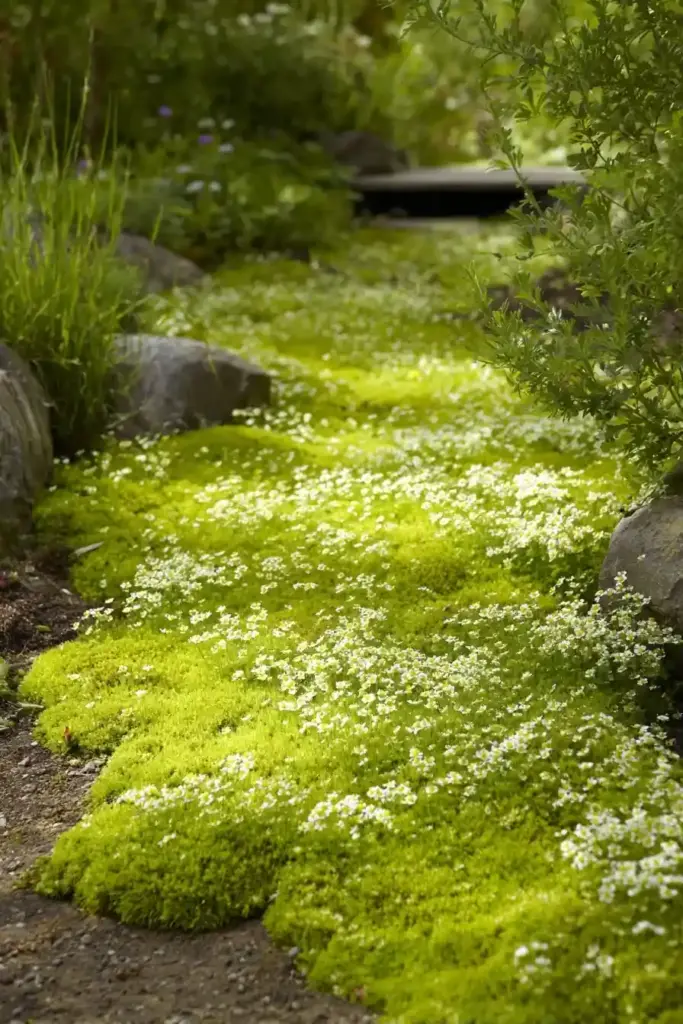
Scotch moss forms a golden-green mat that’s soft underfoot and surprisingly tough. Though moss-like in appearance, it’s technically not a moss and can handle light foot traffic, making it ideal for smaller, shaded pathways or stepping stone gaps.
- Light: Full sun to part shade
- Height: Around 1 inch
- USDA Zones: 4–8
- Best Uses: Between pavers, small lawns, or in alpine-style gardens
- Bonus: Tiny white flowers appear in spring
Watering Note: It needs consistent moisture, especially in hotter climates.
8. Dwarf Mondo Grass (Ophiopogon japonicus ‘Nana’)
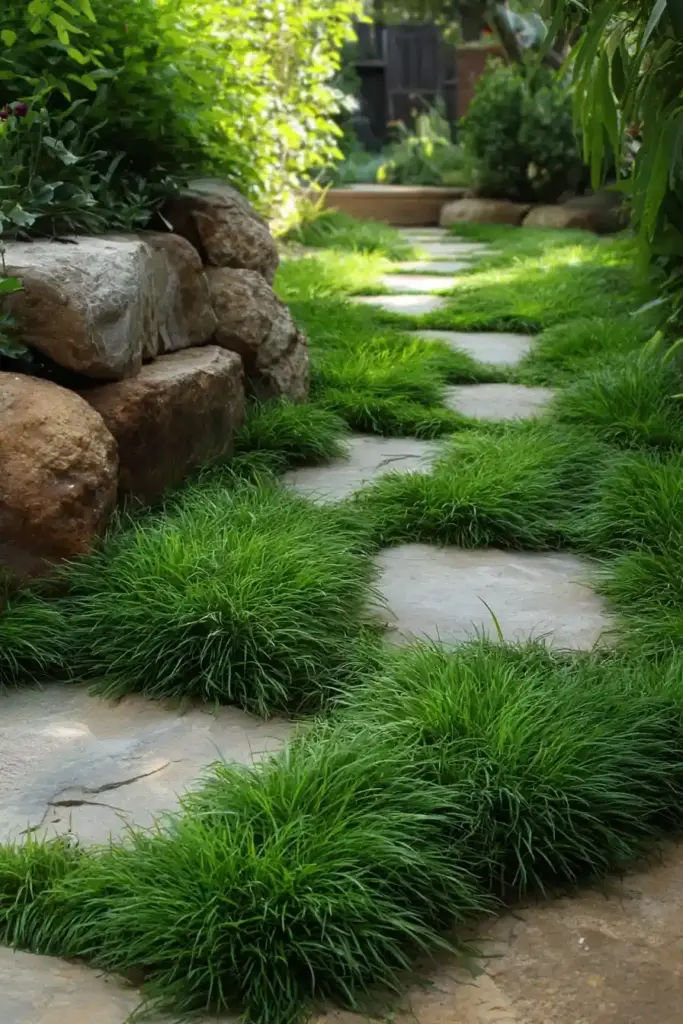
This grass-like plant is a tidy, low-growing option that excels between pavers or in narrow strips. Its rich green clumps create a polished, formal look that requires very little maintenance. It’s also slow-growing, which helps control its spread.
- Light: Full sun to part shade
- Height: Up to 3 inches
- USDA Zones: 7–10
- Best Uses: Pathway edging, between stones, container gardens
- Bonus: Evergreen in warmer climates
Care Tip: Shear it back in early spring to promote lush new growth.
9. Creeping Phlox (Phlox subulata)
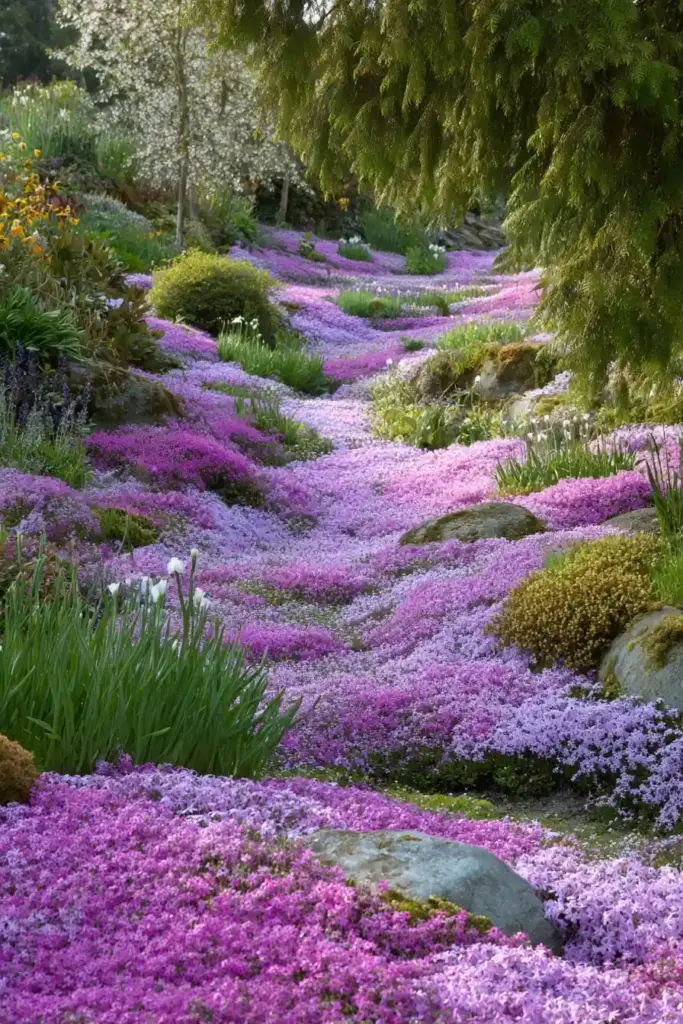
Creeping phlox is a vibrant ground hugger that dazzles in early spring with an explosion of blue, pink, purple, or white flowers. After blooming, its dense, needle-like foliage provides year-round texture and helps with soil erosion.
- Light: Full sun to part shade
- Height: Up to 6 inches
- USDA Zones: 3–8
- Best Uses: Slopes, rock gardens, or sunny path edges
- Bonus: Pollinator-friendly and low maintenance
Blooming Tip: Deadhead after flowering to encourage bushier growth.
10. Snow-in-Summer (Cerastium tomentosum)
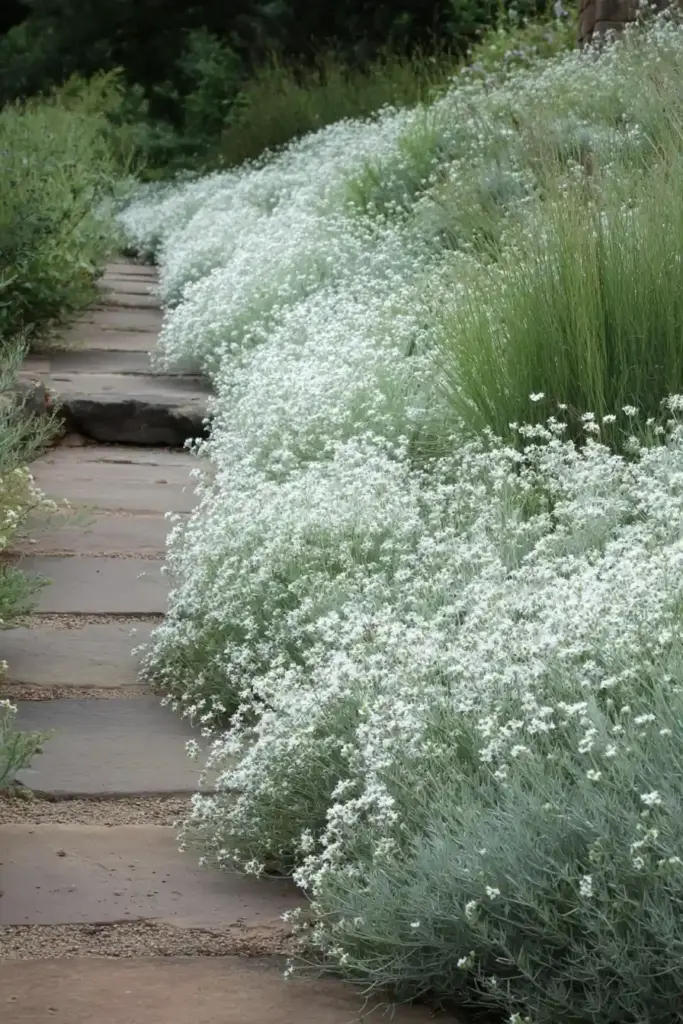
True to its name, Snow-in-Summer carpets the garden with brilliant white flowers in late spring and early summer. Its silver-gray foliage adds contrast and lightens up garden paths throughout the season. While it’s not ideal for heavy traffic, it can tolerate light stepping.
- Light: Full sun
- Height: Up to 12 inches
- USDA Zones: 3–10
- Best Uses: Sunny borders, dry hillsides, and cottage gardens
- Bonus: Deer-resistant and self-sowing (but rarely invasive)
Pruning Tip: Trim after blooming to keep it neat and prevent legginess.
11. Soapwort (Saponaria officinalis)
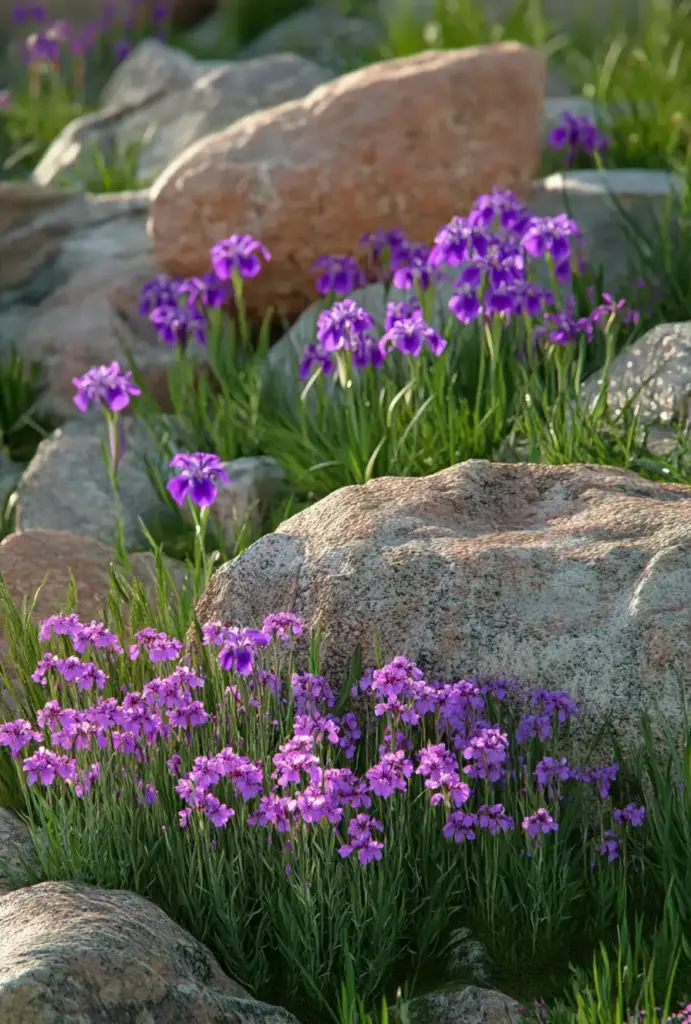
Soapwort is a tough and traditional favorite that brings delicate beauty to garden paths. Historically used for its natural soap-like qualities, this plant now shines in ornamental gardens for its charming pink, white, or red flowers and resilience. It spreads modestly and handles poor soil conditions well.
- Light: Full sun to part shade
- Height: Up to 24 inches
- USDA Zones: 3–9
- Best Uses: Rock gardens, borders, and gently stepped paths
- Bonus: Deer-resistant and drought-tolerant
Fun Fact: Its leaves were once used to make lather for washing—hence the name “soapwort.”
12. Baby Tears (Soleirolia soleirolii)
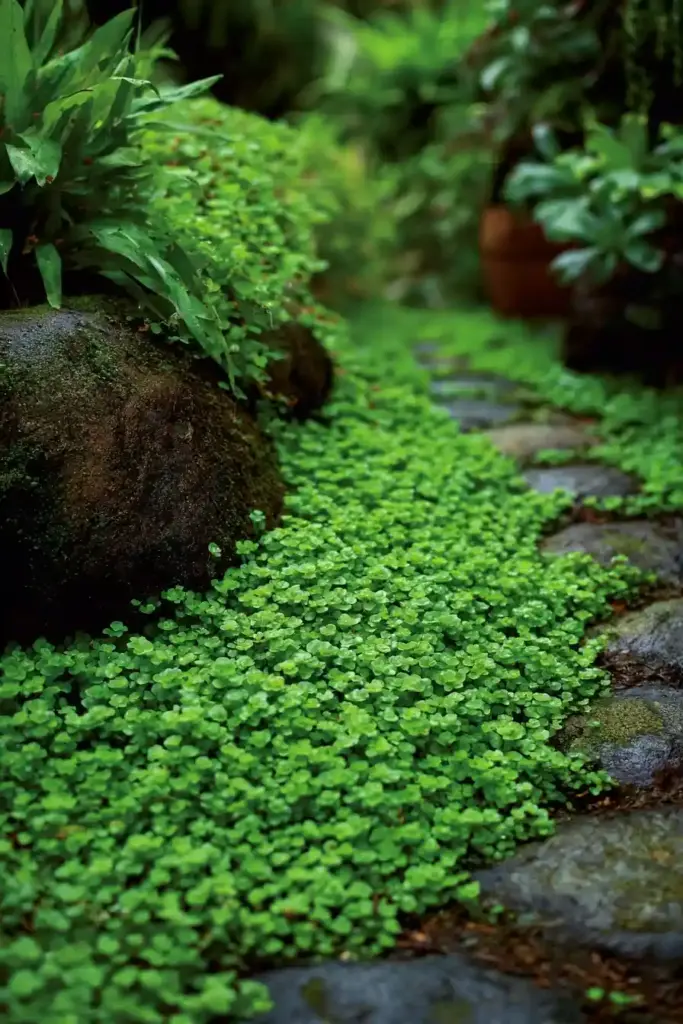
Baby Tears form a lush, moss-like carpet with tiny, bright green leaves. It’s a gentle ground cover perfect for shaded, humid areas. While too delicate for heavy traffic, it adds an enchanting woodland feel to pathways in protected areas or works beautifully in containers.
- Light: Full shade
- Height: Up to 6 inches
- USDA Zones: 9–11
- Best Uses: Shady stepping-stone paths, terrariums, containers
- Bonus: Excellent in vertical gardens and fairy gardens
Note: Needs consistent moisture—avoid letting it dry out.
13. Mazus (Mazus reptans)
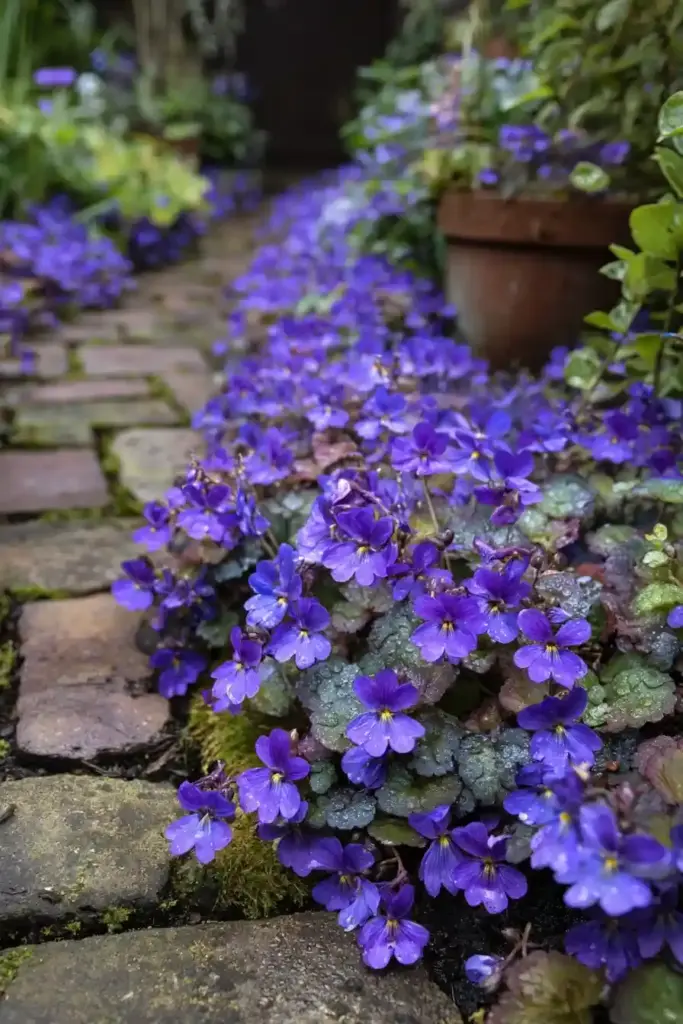
Mazus is a fast-growing, low-maintenance ground cover that spreads quickly to form a dense mat of green. Its small orchid-like purple or blue flowers bloom in spring, creating a cheerful carpet. It’s tough enough to take foot traffic and looks great between pavers or bordering flower beds.
- Light: Full sun to part shade
- Height: Up to 3 inches
- USDA Zones: 5–8
- Best Uses: Walkways, pond edges, or as a lawn substitute
- Bonus: Stays green most of the year in mild climates
Spacing Tip: Plant about 6 inches apart for quick coverage.
14. Hens-and-Chicks (Sempervivum spp.)
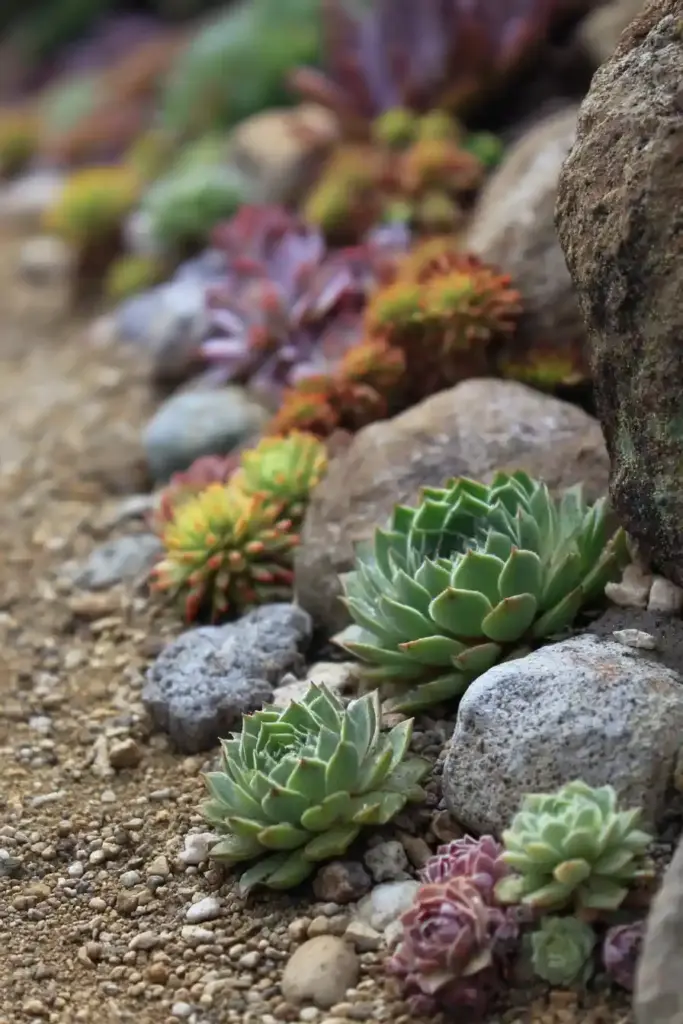
A true rock garden classic, hens-and-chicks produce compact succulent rosettes that multiply freely. The “hen” is the main plant, and the “chicks” are offsets that can be relocated to fill gaps. While hardy and low-water, they prefer minimal stepping and are best used around pavers rather than directly underfoot.
- Light: Full sun
- Height: Up to 12 inches
- USDA Zones: 3–8
- Best Uses: Between stepping stones, rock gardens, and containers
- Bonus: Virtually maintenance-free and frost-hardy
Traffic Note: Avoid walking directly on them—they’re durable but not footproof.
15. Corsican Mint (Mentha requienii)
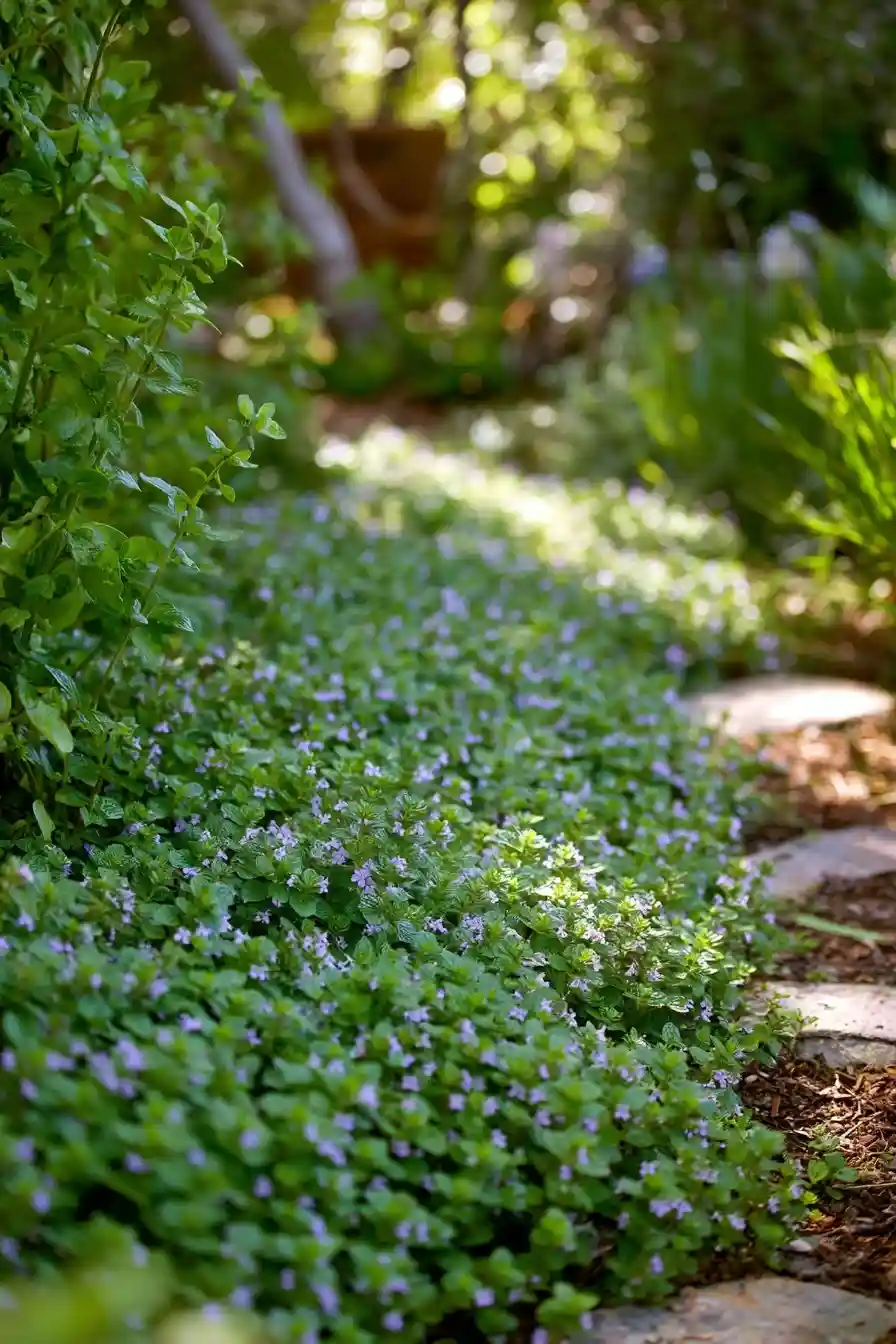
Corsican mint is a petite, aromatic ground cover that forms low, dense mats and thrives in damp, shaded spaces. When walked on, it releases a refreshing minty scent. Its tiny lilac flowers appear in summer, and it performs best in protected locations with light foot traffic.
- Light: Full sun to part shade (afternoon shade in hot climates)
- Height: 1″–3″
- USDA Zones: 6–9
- Best Uses: Between stepping stones, small shaded paths
- Bonus: Adds sensory delight with every step
Soil Tip: Keep soil consistently moist for lush growth.
Tips for Choosing the Right Walkable Ground Cover
Not all walkable ground covers are created equal—selecting the right one depends on your garden’s conditions and how much foot traffic the area will receive. Here are key considerations to help you pick the perfect plant for your pathway:
🌞 1. Assess Sunlight Exposure
- Full Sun: Opt for drought-tolerant species like thyme, sedum, or portulaca.
- Part Shade to Shade: Choose plants such as ajuga, baby tears, or Corsican mint that thrive with less direct light.
🚶 2. Estimate Foot Traffic
- Light Foot Traffic: Most options on this list can handle occasional walking, especially if moisture and spacing are ideal.
- Moderate Foot Traffic: Go for tougher selections like blue star creeper, dwarf mondo grass, or mazus.
- Avoid Heavy Traffic: Even the most resilient ground covers will struggle under constant use—consider stepping stones or gravel pathways in high-use areas with ground cover planted between for beauty and structure.
🌿 3. Match to Soil Type and Drainage
- Well-drained Soil: Ideal for thyme, sedum, and hens-and-chicks.
- Moist Soil: Best for mazus, baby tears, or Corsican mint.
- Poor Soil: Hardy picks like soapwort or creeping phlox thrive even in less fertile conditions.
❄️ 4. Know Your USDA Zone
Always check hardiness zones to ensure long-term survival. For example:
- Cold-Hardy (Zones 3–4): Try creeping phlox, thyme, or snow-in-summer.
- Mild to Warm Zones (7–11): Look to mondo grass, Corsican mint, or baby tears.
🎨 5. Consider Color and Texture
For year-round interest and visual appeal:
- Use golden Creeping Jenny for bright foliage,
- Mix ajuga and scotch moss for varied texture,
- Add flowering options like blue star creeper or mazus to break up green with color.
Caring for Walkable Ground Cover Plants
Although walkable ground covers are generally low-maintenance, giving them the right start and occasional upkeep ensures they thrive for seasons to come. Here are essential care tips to keep your pathway looking lush, inviting, and functional.
🧱 1. Site Preparation Is Key
- Remove weeds and grass before planting—ground covers need a clean slate.
- Loosen soil to about 4–6 inches deep and mix in compost for better drainage and nutrients.
- Add edging to keep aggressive spreaders like creeping Jenny or mazus from overtaking other beds.
💧 2. Watering Wisely
- New plantings: Keep soil consistently moist until roots are established (2–4 weeks).
- Established plants: Water deeply but infrequently—most ground covers prefer occasional soakings over daily misting.
- Drought-tolerant varieties like sedum and soapwort can go longer between waterings.
✂️ 3. Prune and Shear as Needed
- Light trimming keeps spreading types under control and encourages dense, even growth.
- After flowering, shear plants like snow-in-summer, creeping phlox, and ajuga to tidy up and promote reblooming or foliage regrowth.
🍂 4. Mulching and Fertilizing
- Apply a thin layer of mulch between plants (not directly on them) to suppress weeds and retain moisture.
- Fertilize once in spring with a balanced, slow-release fertilizer if the plant shows signs of stress or slow growth.
🚫 5. Foot Traffic Management
- Limit walking during very wet or very dry periods, as plants are more fragile then.
- Consider using stepping stones or gravel strips to direct foot traffic and protect sensitive areas.
- For more delicate plants like baby tears or Corsican mint, confine walking to adjacent stones, not directly on the foliage.
Frequently Asked Questions (FAQ)
❓ What is walkable ground cover?
Walkable ground cover refers to low-growing, hardy plants that can withstand light to moderate foot traffic. These resilient plants are often used between stepping stones or to replace turf grass, offering a mix of beauty, practicality, and ecological benefits. They add texture, color, and often fragrance, making them ideal for creating stunning garden paths with personality.
❓ Can walkable ground cover replace a traditional lawn?
Absolutely. Many walkable ground cover varieties, such as creeping thyme, blue star creeper, or dwarf mondo grass, make excellent lawn alternatives. They are especially valuable in small spaces or shaded areas where grass struggles, providing a low-maintenance solution that reduces the need for mowing, watering, and fertilizing.
❓ Which walkable ground cover is best for full sun?
For sunny pathways and high-heat gardens, try these sun-loving walkable ground cover plants:
- Sedum (Stonecrop)
- Portulaca (Moss Rose)
- Creeping Thyme
- Snow-in-Summer
These thrive in direct sunlight and require minimal irrigation once established, making them perfect for dry climates.
❓ Are there walkable ground covers for shady areas?
Absolutely! For part shade to full shade, try:
- Ajuga (Bugleweed)
- Baby Tears
- Corsican Mint
- Blue Star Creeper
These shade-tolerant plants are ideal for dappled woodland paths or the north side of your home.
❓ How much foot traffic can these plants handle?
Most walkable ground covers are suitable for light foot traffic—occasional walking or stepping. For higher-use paths, consider using stepping stones to protect plants while still enjoying their beauty.
❓ Do walkable ground covers need a lot of maintenance?
In general, no. Many are drought-tolerant and weed-suppressing. Key maintenance includes:
- Occasional watering (until established)
- Light pruning to shape
- Preventing overgrowth or invasiveness in some species like creeping Jenny
❓ Are walkable ground covers pet-safe?
Some, like thyme and mondo grass, are considered safe for pets. However, always check individual plant toxicity—especially for cats and dogs—through reputable sources like the ASPCA.
Conclusion
Incorporating walkable ground cover into your garden pathways is more than just a visual enhancement—it’s a practical, sustainable upgrade that adds year-round beauty and function. Whether you’re interested in drought-tolerant succulents, aromatic herbs like thyme, or colorful flowering mats, there’s a walkable ground cover perfectly suited for your climate, foot traffic level, and design preferences. Choosing the right variety based on your sunlight conditions and USDA zone helps you create a thriving, low-maintenance garden path that not only delights visitors but also supports pollinators.
You don’t need to overhaul your entire yard—start by planting walkable ground cover between pavers or revitalizing a narrow strip of underused space. With time, you’ll cultivate a living path that merges nature with everyday practicality. From rustic cottage gardens to more structured designs, walkable ground cover ensures your garden path becomes more than just a route—it becomes an experience. For more ideas, check out these low-maintenance perennial combinations to complement your ground cover selections.


